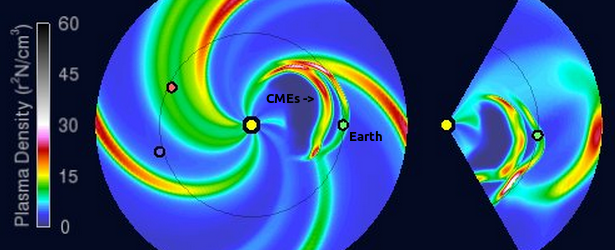Subsiding geomagnetic and solar radiation storms

Geomagnetic storm sparked by a combination of CMEs from last couple of days is now subsiding. We might still see uptick today but it will most likely remain below G1 levels.
At 10:57 UTC on April 20, a 24 nT geomagnetic sudden impulse (interplanetary shockwave passage) was recorded at the Boulder magnetometer. Geomagnetic activity subsequently reached active levels at 12:35 UTC and minor storm (G1) levels by 13:01 UTC. The relatively benign behavior of Bz kept the activity from exceeding minor storm levels.
According to SWPC, minor (G1) storm conditions may persist into the first synoptic period of April 21 with an overnight sub-storm before diminishing to unsettled to active levels on April 22. A return to quiet to unsettled levels are expected on April 22
"The 10 Mev greater than 10 pfu proton event (S1-minor) which began on April 18 at 15:25 UTC reached a maximum of 58 pfu at 01:05 UTC on April 19 before beginning to decline. The decline was interrupted when an interplanetary (IP) shock passage was detected at ACE at 10:57 UTC on April 20. 10 MeV flux briefly rose from 15 pfu to near 30 pfu before plummeting below the 10 pfu threshold at 11:55 UTC on April 20, signaling the end of the proton event.
The greater than 2 MeV electron flux at geosynchronous orbit is expected to be at normal to moderate levels during the rest of the day. The greater than 10 MeV proton flux at geosynchronous orbit is expected to be elevated, but below the 10 pfu threshold. It should gradually return to nominal levels over the next three days with a slight chance for another event on April 21 and 22." (SWPC)



Image credit: NOAA / SWPC
Solar activity has been at low levels during past 24 hours. Only three low level C-class solar flares have been observed by 11:00 UTC on April 21.
There are currently 9 numbered sunspot regions on the Earth side of the Sun. Most regions were stable or decaying during last 34 hours. The three largest regions, 2034 (N04W66, Eko/beta-gamma), 2035 (S16W43, Eai/beta-gamma), and 2036 (S17E68, Dac/beta-gamma) decreased in areal extent from yesterday but retained their beta-gamma magnetic complexity. This large complex regions will exit around the west limb and start their farside rotation over the next couple of days.

Sunspots on April 21, 2014. Image credit: NASA SDO / HMI
2033 N11W84 264 0060 Hsx 02 01 Alpha
2034 N04W66 246 0270 Eko 11 16 Beta-Gamma
2035 S16W43 223 0200 Eai 13 30 Beta-Gamma
2036 S17W68 248 0180 Dac 10 20 Beta-Gamma
2037 S10W67 247 0040 Cao 09 04 Beta
2038 S11W05 185 0080 Dai 06 12 Beta
2042 N19E15 165 0170 Cso 09 04 Beta
2044 S20E37 143 0030 Dro 09 11 Beta
2045 S22E62 118 0050 Cao 03 04 Beta
SWPC forecasters estimate 55% chance of M-class, and 10% chance of X-class solar flares in next three days.
Featured image: NOAA / SWPC – Enlil Solar Wind Prediction model

Commenting rules and guidelines
We value the thoughts and opinions of our readers and welcome healthy discussions on our website. In order to maintain a respectful and positive community, we ask that all commenters follow these rules.